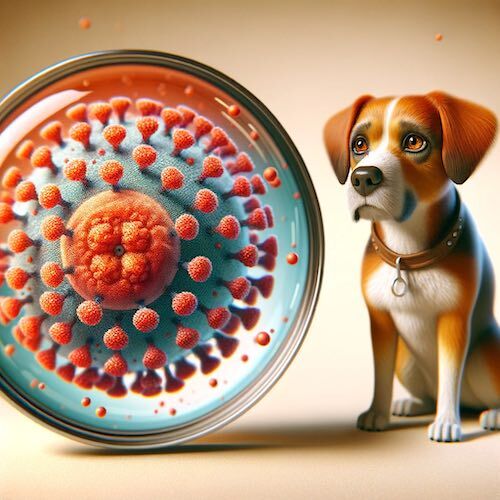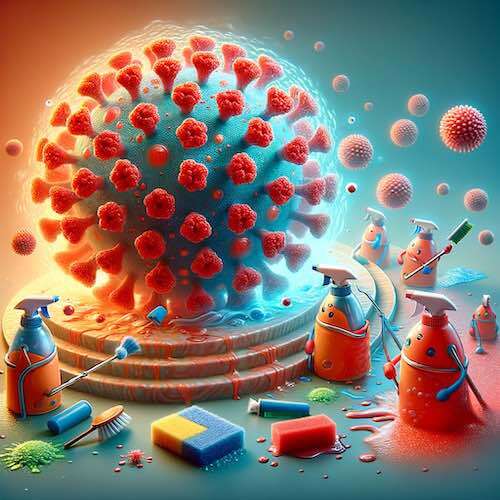Canine Parvovirus: Everything Dog Owners Need to Know
What is Canine Parvovirus?
Canine Parvovirus (CPV), also known as Parvo, is a critical concern for dog owners and veterinarians alike due to its aggressive nature and high mortality rate if left untreated. This DNA virus belongs to the Parvoviridae family and has a particular affinity for attacking the most rapidly dividing cells in the body. When it invades the gastrointestinal tract, it causes severe damage to the intestinal lining, resulting in malabsorption and leading to the hallmark symptoms of bloody diarrhea and vomiting. These symptoms are not only distressing but also lead to rapid dehydration and significant electrolyte imbalances, further endangering the dog’s life.
Moreover, CPV’s impact on the bone marrow and lymphoid tissues hampers the body’s ability to produce white blood cells, crucial defenders against infection. This suppression of the immune system leaves the infected dog vulnerable to a myriad of secondary infections, compounding the disease’s severity. The virus’s mode of transmission is highly efficient, spreading through direct contact with infected feces or indirectly via fomites—objects or materials likely to carry infection, such as clothes, utensils, and even human hands that have not been adequately sanitized.
Search: Best Selling Parvovirus Disinfect Cleaner
First identified in the late 1970s, CPV has since undergone mutations, leading to different strains, including CPV-2a, CPV-2b, and CPV-2c, which vary slightly in their infectivity and impact. Despite the availability of vaccines, the virus remains a significant threat, particularly in environments where dogs congregate, such as kennels, dog parks, and shelters. The resilience of CPV in the environment, capable of withstanding temperature extremes and most cleaning agents, underscores the necessity of thorough disinfection protocols and vaccination to manage and mitigate the risk of this devastating disease.
Symptoms to Watch For
Recognizing the symptoms of Canine Parvovirus (CPV) early on is crucial for the timely treatment and recovery of the affected dog. The disease manifests through several acute and severe symptoms that quickly deteriorate the dog’s health. One of the earliest signs of CPV infection is intense, uncontrollable vomiting followed by bloody diarrhea, which is distinctively malodorous. This combination not only is distressing for the animal but also leads to rapid loss of fluids and nutrients, causing severe dehydration.
As the virus progresses, infected dogs may display a high fever indicating the body’s attempt to fight off the infection. Accompanying the fever, lethargy and an overall lack of energy become apparent as the dog’s system is overwhelmed by the virus. Younger puppies, who are especially vulnerable to CPV, often appear particularly weak and may refuse food or water, showing signs of severe depression and pain due to the discomfort caused by the virus in their intestines.
In the absence of prompt and effective medical intervention, the situation can quickly escalate. The dog’s condition may deteriorate to the point of sepsis, a systemic infection that affects the entire body, or shock, a critical state characterized by a significant drop in blood pressure and circulatory failure. Both conditions are life-threatening and require immediate, intensive care to save the dog’s life.
Beyond these immediate symptoms, CPV can also lead to long-term health issues due to the damage it causes to the gastrointestinal tract and immune system. The severe strain placed on the dog’s body can result in lasting sensitivities or vulnerabilities, underscoring the importance of early detection, preventive vaccination, and rigorous hygiene practices to protect canine companions from this dangerous virus.
Modes of Transmission
Canine Parvovirus (CPV) is a formidable pathogen known for its highly contagious nature and the ability to endure harsh environmental conditions. Its transmission is alarmingly straightforward, occurring when dogs come into direct contact with the feces of an infected dog. However, the risk of transmission is not limited to such direct exposure. CPV can also spread through indirect contact with contaminated objects that range from seemingly innocuous items like toys and feeding bowls to human clothing and shoes. This means that the virus can hitch a ride from the park to the home without the pet owner ever realizing it.
The resilience of CPV in the environment adds another layer of challenge in controlling its spread. It has the chilling ability to remain viable on surfaces and in soil for months or even years under the right conditions. This longevity outside a host makes CPV not just a seasonal concern but a year-round threat to canine health.
Particularly vulnerable are puppies younger than four months, whose immune systems are not fully developed or have not been fully vaccinated against the virus. This vulnerability makes them prime targets for the disease, which can have devastating effects on their health.
Given CPV’s durability and ease of transmission, it’s clear why outbreaks can occur rapidly and why such emphasis is placed on vaccination and hygiene practices. The persistence of the virus in the environment underscores the importance of thorough cleaning and disinfection in areas where dogs frequent, as well as the critical role of preventive healthcare measures. These strategies are essential to protect not only individual pets but also the broader canine community from the widespread impact of this relentless virus.
Proactive Prevention Strategies
The best way to navigate the threat of Parvovirus is to prevent it. Here are the key strategies to protect your dog:
Vaccination: The Protective Shield
Vaccination is the most crucial defense against Canine Parvovirus. Puppies need a series of Parvo vaccinations starting as early as 6 weeks of age, followed by regularly scheduled boosters. Adult dogs should maintain their booster schedule as recommended by their veterinarian. While vaccines don’t guarantee 100% immunity, they significantly reduce the likelihood of severe illness and offer the best chance for survival if the dog is exposed.
Hygiene: The Foundation of Prevention
Alongside vaccination, strict hygiene practices are essential to prevent the spread of Parvovirus. This includes:
- Thorough Disinfection: Clean contaminated areas with a bleach solution (1 part bleach to 30 parts water) as the virus is resistant to many household cleaners.
- Diligent Handwashing: Wash hands frequently with soap and water, especially before and after handling dogs. Change clothes if you’ve been in contact with a potentially infected dog.
- Limiting Exposure: Restrict your unvaccinated puppy’s interactions with other dogs and heavily trafficked areas like dog parks until they complete their vaccination series. Parvo can linger in the environment for extended periods.
- Responsive Measures if Parvovirus Strikes
Immediate Veterinary Intervention
Time is of the essence if you suspect Parvovirus. Seek urgent veterinary care as soon as you notice any symptoms. Early diagnosis and aggressive treatment offer the best chance for your dog’s recovery.
Isolation
Isolate your infected dog immediately to prevent further spread. Thoroughly clean and disinfect their living area and belongings, using a bleach solution. Limit their contact with other dogs in your household.
Supportive Care
Unfortunately, there is no cure for Parvovirus. Treatment centers on supportive care to address the severe symptoms. Veterinarians typically prescribe IV fluids to combat dehydration, medications to control vomiting and diarrhea, antibiotics to fight secondary infections, and nutritional support.
Vigilance and responsible pet ownership are your greatest allies against Parvovirus. With the combined power of vaccination, hygiene, and prompt action, you can dramatically reduce the risk of this devastating disease impacting your beloved dog.
Isolation and Comprehensive Treatment
-
Isolation: Containing the Spread: Immediately isolating a dog diagnosed with Parvovirus is vital to prevent further infections. This means confining them to a designated area and diligently cleaning and disinfecting all surfaces they’ve contacted using a bleach solution. Parvovirus can persist in the environment, so restrict access for other animals. You should also inform anyone with dogs about potential exposure, so they can monitor their pets for symptoms.
-
Support is Key: No Cure, But Treatment Helps: Unfortunately, there’s no direct cure for Parvovirus. Treatment focuses on supportive care to address the severe symptoms, giving the dog’s immune system the best chance to fight the infection. This typically includes:
- IV Fluids: Critical for combating dehydration, a major danger caused by ongoing vomiting and diarrhea.
- Medications: Antiemetics to control vomiting, antidiarrheals, and antibiotics to prevent or treat secondary bacterial infections
- Nutritional Support: For dogs unable to keep food down, liquid diets, or feeding tubes may be necessary.
- Hospitalization: Severe cases often require 24/7 hospital care for intensive monitoring, fluid administration, and other interventions.
-
The Long Road: Recovery time varies, but often involves careful management at home to continue supportive care and ensure full return to health. Even after recovery, dogs may continue to shed the virus for several weeks. Your veterinarian will advise you on when it’s safe for your dog to resume normal interaction with other dogs.
Further Considerations and Owner Responsibilities
While all unvaccinated dogs are at risk of Parvovirus, some breeds face increased vulnerability to severe infections. This includes Rottweilers, Doberman Pinschers, German Shepherds, American Pit Bull Terriers, and English Springer Spaniels. The exact reasons for this elevated susceptibility are still being researched, but it might be linked to genetic factors affecting their immune response to the virus.
What This Means for Owners: If you own a dog belonging to a predisposed breed, it’s even more crucial to prioritize timely vaccinations and maintain them according to your veterinarian’s recommendations. Additional precautions like exercising extra careful hygiene, particularly with young puppies, as well as limiting their exposure to unvaccinated dogs, can make a significant difference.
Knowing that your dog’s breed may carry a higher risk empowers you to be even more proactive in protecting them against Parvovirus. Consulting with your veterinarian about any specific concerns regarding your dog’s vulnerability is always recommended.
Ownership and Preventative Care
Parvovirus is a preventable disease, and with it comes a responsibility towards both our own dogs and the dog community at large. As responsible pet owners, we hold the power to protect our furry companions against this severe threat through a multifaceted approach:
- Vaccinate: Adhering to a diligent vaccination schedule, starting with puppyhood and maintaining boosters as recommended by your veterinarian, is the single most powerful weapon against Parvovirus.
- Hygiene: Thorough cleaning and disinfection, especially with bleach as the virus is highly resilient, is essential in breaking the spread. This matters both at home and in shared spaces used by dogs.
- Act Fast: Never hesitate to seek immediate veterinary attention if you suspect Parvovirus. Early diagnosis and treatment significantly improve survival rates.
Further Learning and Support
Understanding Canine Parvovirus, its implications, and the measures to combat it is vital for every dog owner. For more detailed information, resources like the American Veterinary Medical Association or consultations with your veterinarian can offer guidance on vaccination schedules, immediate care strategies, and how to maintain a safe environment for your pet and others.
More Sources:
American Veterinary Medical Association (AVMA): https://www.avma.org/resources-tools/pet-owners/petcare/canine-parvovirus. Offers reliable information on Parvo symptoms, treatment, and prevention
Your Veterinarian: Your primary source of reliable information, and guidance, and the best resource to create a vaccination plan and provide immediate care in case of Parvo infection.

